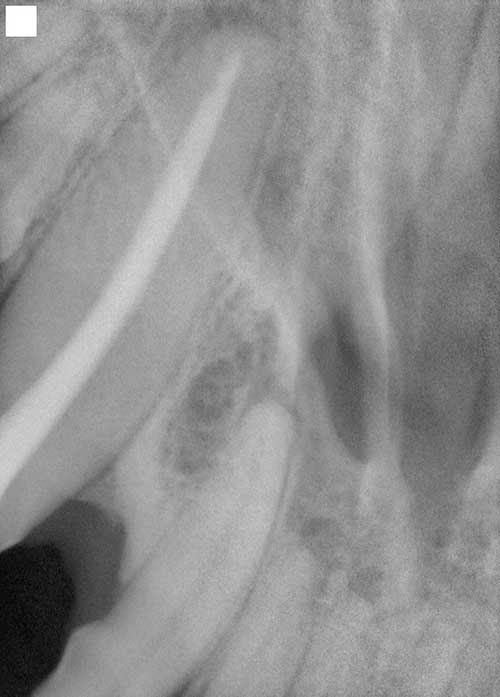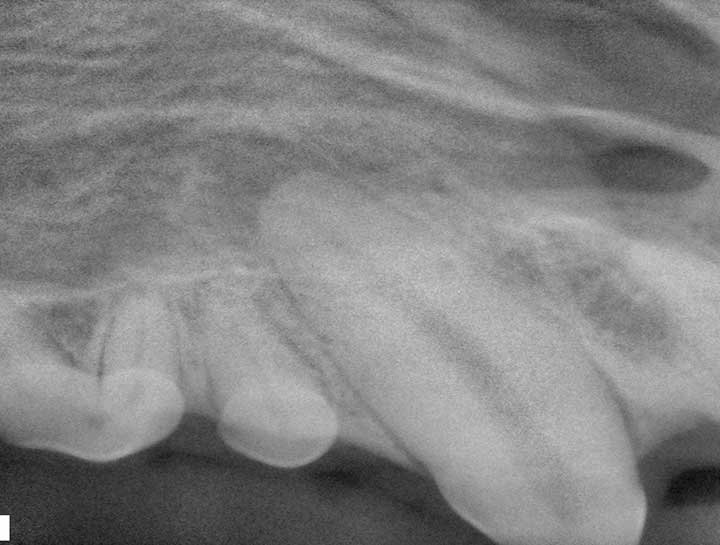Endodontic Therapy
Saving damaged teeth.
We commonly provide endodontic or root canal therapy at our practice. Root canal therapy is performed to save a tooth when damage to the tooth has resulted in death of the pulp tissue. The pulp tissue contains the blood vessels, nerves, and connective tissue that support cells responsible for the production of the dentin layer of the tooth. The dentin layer, which is produced throughout the pet’s lifespan, serves to thicken and solidify the tooth.
The most common cause of pulpal death is damage to the crown, either through trauma or chewing on hard items such as bones, rocks, ice, horse hooves or almost anything harder than the tooth itself. Excessive wear of teeth from ball chewing or cage biting can also cause pulpal death.
If external damage to the crown allows bacteria into the pulp tissue, the tissue will die. Often the infection will spread into the apex of the tooth root (tip of the root) resulting in a bone infection around the root tip (peri-apical disease). Many times this infection goes on unchecked for a long time (months or years) and can result in pain and potentially seed other major organs systemically with bacteria or bacterial “toxins”.
Undiagnosed mouth pain can result in behavioral issues and poor quality of life for your pet.
It is not uncommon for us to see less affectionate pets with chronic mouth pain. It can also affect working dogs like police dogs, or hunting dogs perhaps affecting bite-work training or retrieval skills. Sometimes with tooth abscess there may be external signs of disease, such as swelling of tissues or a draining fistulous tract inside the mouth. Most teeth with peri-apical disease require x-rays to diagnose the specific tooth in question. It is not uncommon for animals to exhibit no signs of tooth pain at all despite an infected tooth. They may hide it by chewing on non-affected molars.
External trauma or thermal injury to a tooth without crown damage can result in pulpitis (inflamed dental pulp). Initially the tooth becomes pink and over time changes to purple, and then gray. These teeth may also require endodontic therapy.
In acutely fractured teeth with pulp exposure, the exposed pulp can be sealed by a procedure called direct or indirect pulp capping. For good results, this procedure should be performed within 48 hours of the injury. The goal is to protect and seal the exposed pulp from bacteria before it can transition into the deeper tissues and result in pulpal death. Although there are no guarantees, these procedures can significantly reduce the probability of pulpal death and prevent the need for a root canal later. After pulp capping, teeth need to be monitored over time for evidence of infection. Determining which procedure to use depends on the animal’s age; patients younger than 9 months old will require a vital pulpotomy to stimulate the closure of the root tip before root canal therapy could be utilized.

Root canal therapy in pets is virtually identical to that in people. The diseased pulp tissue must be removed and cleaned with specialized instruments and techniques, the canal(s) and pulp chambers will be filled with an inert material, and the access area to the pulp canal or chambers is repaired with restorative materials. Teeth with only one canal will take significantly less time to treat than those triple-rooted teeth like the carnassial teeth. After root canal therapy, treated teeth need to be monitored over time to be certain the procedure has been successful.
Call us at (530) 272-6651 today to schedule your pet's next dental exam!

